Welcome to the topic of Festivals and Events
While there is much to see and do in so many places around the world, the opportunity to immerse yourself with culture can truly be explored through the festivals and events unique to a country, nature or belief.
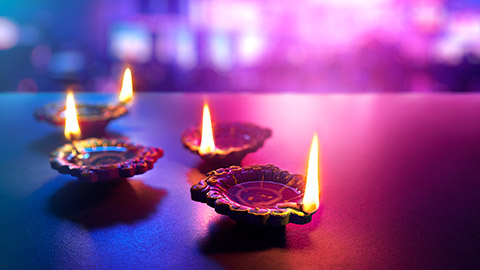
A very important date on the Hindu calendar is Diwali or Divali – a huge festival full of colours and lights. The spiritual significance of Diwali is that it marks the victory of good over evil and the triumph of light over darkness. Diwali takes place annually and lasts for five days, marking the start of the Hindu New Year.
The 5 Days of Diwali
The first day of Diwali is called Dhan Theras
This day is spent worshipping their goddess Lakshmi. People clean and decorate their homes.
The second day of Diwali is called Narak Chaturdasi
On this day Lord Krishna destroyed the demon Narakasur and made the world free from fear. People celebrate by waking up early and applying aromatic oils on them before taking a bath. This is said to remove all sins and impurities.
The third day of Diwali is the actual Diwali
This is the day when they worship as Goddess Lakshmi is believed to enter homes and bless people with good fortune. Candles and electric lights are placed around the house. Families exchange gifts and gather together to burst crackers.
On the fourth day of Diwali, Goverdhan Pooja is performed
It is the day when Lord Krishna defeated Indra by lifting the huge Govardhan Mountain. People make a small hillock, usually of cow dung, symbolising Govardhan and worship it.
The fifth day of the Diwali is called Bhratri Dooj
It is a day dedicated to sisters where they invite their families over for a lavish meal and perform a ‘tilak’ ceremony where they pray for long life and health.
Take a break from the reading and watch this short video of the Diwali festival- NOTE this may help you in your end of topic quiz
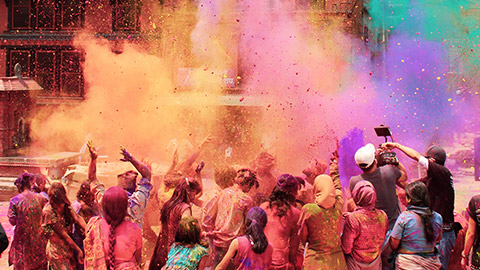
This colourful festival of Holi is celebrated on Phalgun Purnima (which is a month of the Hindu calendar in India) and it is a celebration of the victory of good over evil – and it marks the arrival of spring the day after the full moon in march each year. People celebrate this holiday over 2 days as they wish each other “Happy Holi”.
People spend the day smearing coloured powder (Gulal) all over each other's faces, throwing coloured water at each other, having parties and dancing under water sprinklers. As fun as this is, there is a reason behind the colours as they are thought to signify specific things
- Red is for love and fertility
- Blue is for their lord Krishna
- Yellow natural remedy for health
- Green signifies new beginnings.
Special Holi events with music, rain dances, and colours are organized in large cities across India, particularly in Delhi and Mumbai.
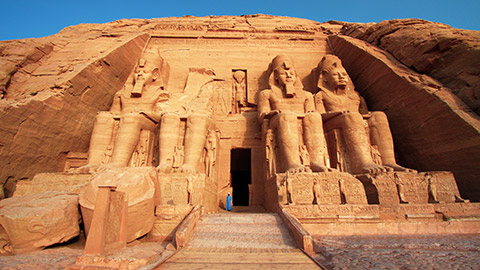
Abu Simbel Festival is a very significant and unique festival which celebrates the combination of human endeavour and natural phenomena.
It recognises Rameses and his clever temple design that aligned with the sun to illuminate his statue and the whole inner sanctum twice a year, specifically on the date of his birthday and the anniversary of his rise to the throne.
During the Abu Simbel Festival crowds fill the temple at sunrise to watch the shafts of light creeping across the stones. After the spectacle, the crowds move outside for celebrations of music, dancing, eating, drinking and markets.
Abu Simbel are two huge rock temples on the banks of Lake Nasser, it is part of a World Heritage Site known as “Nubian Monuments”. The two temples were carved in the 13th century out of the mountainside as a monument to Pharaoh Ramses II and his queen Nefertari.
To find out more, visit: hellotravel.com
The Pyramids Marathon takes place in February and invites runners from around the world to run at the most iconic of locations, The Great Pyramids of Giza.
Egypt’s signature running event doesn’t just offer the 42K, but also the 21K and 10K distances, meaning anyone can take part and run through 5000 years of history!
The Pyramids Marathon takes you up close and personal to the Pyramids and each race features a one-lap route which starts and finishes at the Pyramids.
The 42km runners have 6 hours to complete the full marathon while the 10 and 21 km runners have 4 hours before the final cut-off time of 12:00pm.
Visit this website to find out more - pyramidsmarathon.com
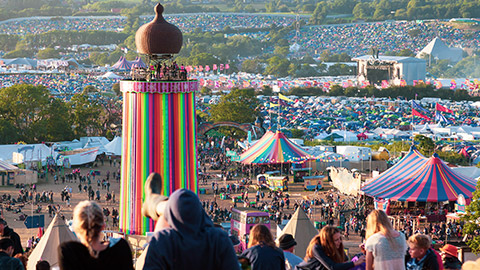
Glastonbury (greenfield) is a huge festival of music and contemporary performing arts which takes place on Worthy Farm in Pilton, Vale of Avalon – on an area of 900 acres. It is the largest ‘green field’ music and performing arts festival in the world that is held over 5 days.
The very first festival was held in 1970, the day after Jimi Hendrix died, approximately 1,500 attended. Nowadays, the maximum number of tickets sold is 140,000 – which always sell out extremely fast.

An annual celebration on the evening of 5th November. It celebrates the foiling of the Gunpowder Plot, when several conspirators, including Guy Fawkes himself, were alleged to be attempting to blow up the Houses of Parliament in London, England.
Popular traditions on Guy Fawkes night is the burning of “guys” on a bonfire. The ‘guy/effigy’ is a reminder of Guy Fawkes; they are made like a scarecrow.
In New Zealand, Guy Fawkes is also a popular event on the 5th November. The general public can purchase fireworks for a few days leading up to the event, but you have to be at least 18 years old. Large public displays are usually held in the main centres also.
Halloween is a massive day of celebration in North America! It is a holiday celebrated each year on October 31 which include activities such as trick-or-treating, bonfires, carving pumpkin lanterns, visiting haunted attractions and dressing-up in a scary outfit!
The tradition originated with the ancient Celtic festival of Samhain, when people would light bonfires and wear costumes to ward off ghosts, however over the years has turned into a family outing where children are able to dress up and go trick-or-treating!
To find out more, visit: usa.usembassy.de
Both Canada and the USA celebrate Thanksgiving but on different days. Canada celebrates it on the second Monday of October and the USA celebrates it on the fourth Thursday of November.
The festival dates back to 1621 when pilgrims held a feast to give thanks for a bountiful harvest season. The Thanksgiving feast is a national tradition to express thanks. Before the meal begins, families or friends usually pause to give thanks for their blessings, plentiful food and the joy of being united for the occasion. They also often give thanks for their freedom, harvests and safe journeys.
Visit this website to find out more usa.usembassy.de
Affectionately referred to as “Africa’s Grandest Gathering”, the Cape Town International Jazz Festival, is the largest music event in sub-Saharan Africa. The Cape Town International Jazz Festival (CTIJF), which held its first event in 2000, is an annual event. It is famous for delivering a star-studded line up. This proudly South African produced event is hosted at the Cape Town International Convention Centre (CTICC) each year on the last weekend of March or the first weekend of April.
The festival annually boasts 5 stages and over 40 artists performing over 2 nights. The programming - unique to the CTIJF, is made up of a 50/50 split between South African and international artists. The festival hosts in excess of 37,000 music lovers over the 2 days.
Doors open at around 6:00pm on the Friday and the event ends around 12am. On the Saturday, doors open slightly earlier at 4:30pm and close again at 12am.
Every year tickets are sold out fast, so early booking is essential.
Fascinating facts
- Marabi* was the first form of jazz native to South Africa
- Cape jazz incorporates American blues, folk and similar themes of social hardship and displacement.
- Goema sounds followed the path of marabi and Cape jazz; Goema was led by the Goema Captains who made changes to Cape songs typical structure but allowed for more of an innovative approach in the genre.
- Due to racially separatist Apartheid law; Saxophonist legend, Winston Mankunku Ngosi played behind a curtain when performing with his white band members. In 1968, Winston won the Castle Lager Jazz Musician of the Year for the song, Yakhal’ Inkomo.
* Marabi was a South African style of music rooted in jazz mixed with sounds of African rhythm. Marabi is characterised by piano jazz and flourished in the Sophiatown era, where it was played in shebeens* and dance halls.
*A shebeen was seen as an unlicensed establishment or private house selling alcohol and typically regarded as slightly disreputable. A shebeen in modern times are informal licensed drinking places in a township. The word stems from the Irish síbín, meaning 'illicit whiskey'
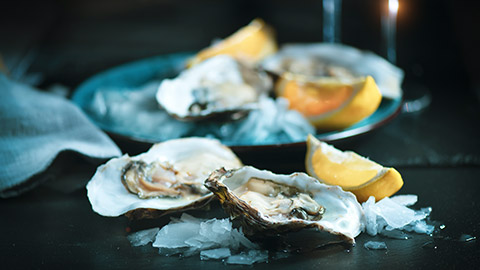
The following is sourced from: oysterfestival.co.za
The Pick n Pay Knysna Oyster Festival is a 10-day event aimed at foodies, sports lovers and families.
Oyster eating, oyster shucking, oyster farm tours, oyster recipe challenges and gourmet oyster-themed dinners happen throughout the festival, along with wine and champagne tastings.
The oyster festival attracts over 70 000 visitors annually; particularly food lovers who slurp and swallow their way through more than 200 000 oysters at over 20 dedicated oyster venues. Here the delectable molluscs can be eaten au naturel or cooked in a variety of ways.
The Oyster Festival has a packed and varied programme of entertainment with everything from concerts to comedy and talent shows to fashion shows.
There’s something for everyone! It includes (but not limited to):
- Paddling
- Golf
- Bowls
- Soccer
- Angling
- mountain biking
- theatre shows
- craft workshops
- cooking demonstrations
- bridge contests and many more fun activities/entertainment!
You can view the events program following this link: knysnaoysterfestival.co.za

Día de los Muertos (Day of the Dead) is a holiday celebrated throughout Mexico and parts of South America. The holiday focuses on gatherings of family and friends to pray for and remember friends and family members who have died and help support their spiritual journey.
It is known for the costumes representing the dead. People of all ages dress up as skeletons and have their faces coated artfully with paint to resemble skulls, and mimick the *Calavera Catrina. Suits and decorative dresses are worn and some wear shells or other noisemakers to add to the fun and excitement. Others wear these to 'awaken the dead' or keep them close during the event.
Traditions connected with the holiday include building private altars called ‘ofrendas’. These honor the deceased by using sugar skulls, marigolds and the favourite foods and beverages of the departed, and visiting graves with these as gifts. Visitors also leave possessions of the deceased at the graves.
This is very different to the Halloween which is celebrated in the USA and other parts of the world. Whereas Halloween is a dark festival full of mischief and terror, the Dia de los Muertos (Day of the Dead) is an explosion of colour. The point is to demonstrate love and respect for family members who have passed, and revellers do this by holding parties, wearing costumes, singing and dancing.
* Though the literal meaning of the word is defined as ‘skull’, The Calavera is a poetic genre which includes a phrase or form of words written in memory of a person who has died. Calaveras are meant to poke fun at people as if they were already dead and they are usually on the eve of the Day of the Dead.

The word Carnival is traced to a document of the Doge Vitale Falier of 1094, where it was used for the first time when referring to public amusements. In 1296, the Senate declared the Carnival in Venice a public holiday event the day before the commencement of Lent.
The tradition of carnival dates back over 900 years. It was the one time during the year when there were no bounds. Everybody was free to do things they desired all year without any guilt, thanks to the masks.
In Italy, it is celebrated in different ways from city to city. The most popular is the Carnival of Venice.
During the carnival, the city comes alive with masked Venetians and tourists. Bands, jugglers and entertainers are everywhere, and the canals are full of colourful boats. The nights are also full of parties and masked balls.
Some of the more popular masks include the following:
Bauta
This mask was one of the reknown and highly popular Venetian masks. The bauta was a white mask called *larva, a tricorn hat is placed on top of it, and a dark coat, the tabarro, completes the outfit.
The baùta was not only used in many cases within the Carnival period, but also on many other occasions; at the theater, for example, at parties, on dates, and whenever someone wanted the freedom to court or be courted, while remaining completely anonymous. It was used by both men and women, although it was a predominantly male costume.
Moretta
This was a popular choice amongst women. This mask is a small, oval shaped and made of dark velvet. Typically this mask is worn with a hat and decorated with veils. It was worn by women when they went to visit the nuns. This style was imported from France and was quickly adopted in Venice due to it’s ability to highlight female features.
Wearing the Moretta mask meant the mask wearer could not speak as they had to hold a small button in their mouth to keep it in place. This fit especially well the essence of the Venice Carnival as women were able to remain totally anonymous and engage in any sort of forbidden act.
Gnaga
This mask was commonly used by men to dress up as women. The costume consists of regular female clothing and a mask with a feline-like look; the wearer would most likely carry a basket containing a kitten and pretended to be an ordinary woman. The mask wearer could be heard making shrill sounds and meowing.
*the word Larva derives from the Latin, meaning ‘ghost’ or ‘mask’
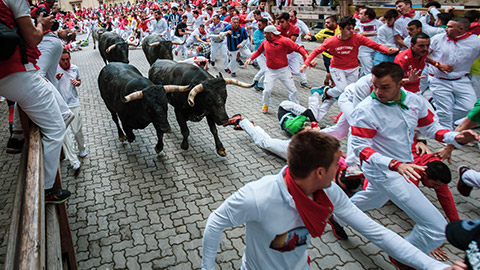
The festival of San Fermin, or the Running of the Bulls as it’s more commonly known outside Spain, is a race with fighting bulls which is held between 7- 14th July.
The Pamplona bull run takes place at 8:00am every morning from 7th to 14th July (eight runs in total). Runners must be in the running area by 7:30am. The length of the run is 825 metres and the average time of the run from start to finish is about three minutes. The streets where the bull run takes place are walled off, so the bulls can’t escape. It is an extremely dangerous activity to join- 15 people have died and over 200 seriously injured since 1924!
Apart from the adrenaline-fuelled bull runs, there’s also feasting, dancing, market stalls and traditional music.
Sadly, San Fermin has been cancelled for the year 2020 due to Coronavirus. It is not the only time in history that the fiesta has been cancelled. The event was also suspended in 1937 and 1938 during the Spanish Civil War, and also in 1978 after a student was shot during clashes between police and protesters calling for an independent Basque region.
The tradition says that you only wear the red scarf on your neck while the festival lasts; the red scarf is a distinguishing element of the San Fermín festival.
Prior to the rocket being fired, people have it on their wrist, in their pocket or in their hand, waving it in the air when the person responsible for starting the festival shouts, “Viva San Fermín, Gora San Fermín”.
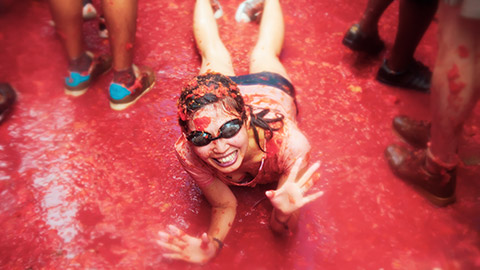
This is a festival that is held in the Valencian town of Buñol (30km from the Mediterranean), in which participants throw tomatoes purely for fun.
It is held annually on the last Wednesday of August, during a week of festivities in Buñol.
It was started in 1950 by accident and the locals kept the traditional going until it was made official in 1957. Now it attracts thousands of visitors each year.
The event is held for locals and people from all over the world, however the maximum capacity is 20,000 participants. Prior to 2013, anywhere from 40,000 to 50,000 (reports show 50,000 in 2012) people crammed into this huge tomato battle. All participants are required to be at least 18 years old and have purchased a ticket to participate.
It is not known how this event was created. There are some theories on how the Tomatina began include a local food fight among friends, a juvenile class war, a volley of tomatoes from bystanders at a carnival parade, a practical joke on a bad musician, and the anarchic aftermath of an accidental lorry spillage.
One popular theory is that a group of unhappy residents attacked city councilmen with tomatoes during a town celebration. Whatever the story way, it was enjoyed so much that it was repeated the following year, and the year after that, and continues on to this day. During the Spanish State period under Francisco Franco, the holiday was banned for having no religious importance but returned in the 1970s after his passing.
The festival is in honour of the town's patron saints, Luis Bertran and the Mare de Deu dels Desemparats (Mother of God of the Defenseless), another name of the Virgin Mary.
References
My Cape Town Stay, (2020, April 29) Cape Town International Jazz Festival
Holiday Bug, (2020, April 29)
South Africa Online, (2020, April 29) Marabi South African Music
Online Dictionary, (2020, April 29) Definitions
El Universal, (2020, April 29) everything you need to know about literary calaveras
Veneto Inside, (2020, April 29) Venice Carnival
Italy Magazine, (2020, April 29) Venice Carnival’s Most Typical Masks and Costumes
Culture Trip, (2020, April 29) 10 Reasons Why You Should Visit Pamplona, Spain
The Local es, (2020, April 29) running of the bulls pamplonas san fermin cancelled over coronavirus
Sanfermin, (2020, April 29) What is Sanfermin
La Tomatina Festival, (2020, April 29) La Tomatina Festival
Lonely Planet, (2020, April 29) La tomatina Guide
La Tomatina Tours, (2020, April 29) La Tomatina Tours
Independent, (2020, April 28) When is the festival of lights and how is it celebrated around the world
Diwali Festival Org (2020, April 28) Diwali the festival of lights
Holi Festival Org (2020, April 29) Holi- Let the colour shower joy
On the go tours (2020, April 29) A guide to the Abu Simbel Sun Festival in Egypt
South African Airways- A Star Alliance (2020, April 28) Abu Simbel, Festival of Sun
Glastonbury Festival UK (2020, April 29) Glastonbury Festival of contemporary performing arts
US Embassy (2020, April 29) Us Embassy, American Holidays Halloween
